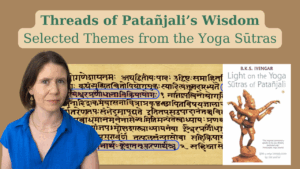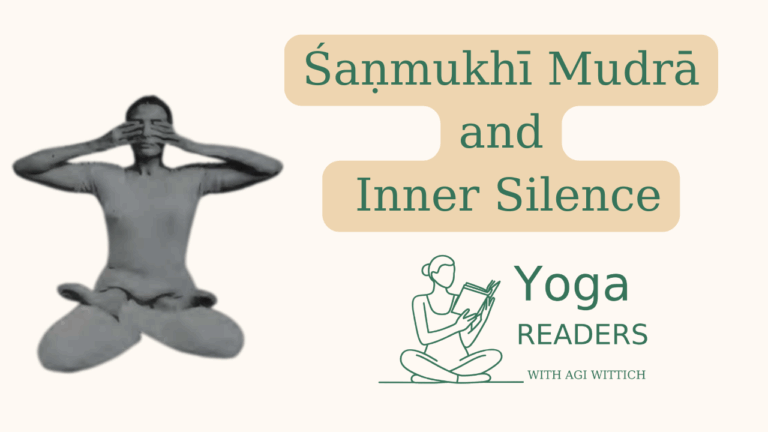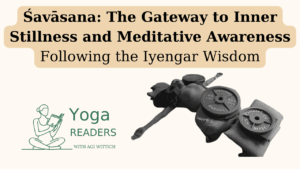
Threads of Patanjali’s Wisdom – Online Course
A course of selected themes from the Yoga Sutras with Dr. Agi Wittich The Yoga Sūtras of Patañjali are the philosophical heart of yoga.

From Book Session: Unit 8 of Geeta Iyengar's Yoga a Gem for Women: Prāṇāyāma and Meditation
In the rich tradition of yoga, Śaṇmukhī Mudrā stands as a profound technique for sensory withdrawal and inner awareness. As Geeta Iyengar explains in “Yoga: A Gem for Women,” this mudrā is “dedicated to the six-headed Kartikeya, the leader of the divine army” and is also known as “Parangmukhi, Sambhavi, and Yoni Mudrā.”
The practice involves a precise sealing of the sensory organs. Geeta Iyengar provides detailed instructions: “The Yogi here seals the organs of sense and looks within himself.” The technique begins with a proper seated position, preferably in Padmāsana, with the spine erect and the head balanced as if floating.
The placement of the hands is crucial and specific. As Geeta describes, the thumbs are inserted in the ears “to shut off all external sound,” while the index and middle fingers gently press the closed eyes. The ring fingers are placed “at the root of the nose, near the nasal passages,” and the little fingers rest “just above the upper lip and under the nostrils.”
What makes this mudrā particularly powerful is its effect on consciousness. “As the eyeballs are closed and pressed, draw the sight inwards,” Geeta instructs. This isn’t merely a physical closing of the senses but an active redirection of awareness. The pressure on the eyes and nasal passages must be “equal on both sides,” creating a balanced state of withdrawal.
The benefits of this practice are profound. According to Geeta Iyengar, “The sense organs are drawn inwards and are thus controlled. Breathing is rhythmic; this calms the mind and one experiences Joy.” The mudrā is particularly effective for “removing irritation, tension, loss of temper, dizziness, burning in the eyes, blurred vision, and brain fatigue due to intellectual work.”
While the physical technique is important, the real essence of Śaṇmukhī Mudrā lies in its ability to facilitate pratyāhāra (sensory withdrawal). As practitioners close their physical senses, they’re invited to experience what Geeta describes as “the light and the darkness which take place in front of the closed eyes, the colourful patterns, and the humming sound in the ears.” This inner control of the senses and prāṇa aligns beautifully with Guruji’s teachings from “Light on Life” Chapter 3: Vitality – The Energy Body, where the flow of energy is refined through awareness.
The practice brings about a unique state of consciousness where external stimuli are minimized, allowing the practitioner to turn attention inward. Geeta notes that practitioners should “listen to the humming sound in the ears. Your mind will be at peace due to this inner sound and inner vision.” Ṣaṇmukhī Mudrā quiets the annamaya and pranamaya levels and draws awareness toward subtler sheaths, as explained in my guide on The Pañca Kośas: The Five Layers of the Self.
The mudrā should be practiced with care and awareness. If pressure on the eyeballs is too intense, Geeta advises that “the sight is blurred due to pressure on the eyes, close the eyes again. Do not be alarmed. This happens when the pressure on the eyeballs is too hard; therefore, next time do not press so much.”
Śaṇmukhī Mudrā can be practiced at any time and is particularly beneficial before sleep. It serves as excellent preparation for meditation and prāṇāyāma, helping to establish the internal focus necessary for deeper practices.
In our contemporary world of constant sensory stimulation, Śaṇmukhī Mudrā offers a valuable tool for finding inner quiet. By physically sealing the senses, practitioners create a space for internal awareness that can be challenging to access in daily life.
The practice reminds us that true peace comes not from eliminating external disturbances but from finding stillness within, regardless of outer conditions. Through regular practice, Śaṇmukhī Mudrā becomes a gateway to experiencing what Geeta describes as the natural state of inner peace and joy that lies beyond sensory experience.
This ancient technique, when practiced with proper guidance and awareness, continues to offer modern practitioners a direct path to inner silence and renewed awareness, making it as relevant today as it was in classical yoga traditions.
If this article nourished your practice, feel free to Buy me a chai to support more in-depth yogic explorations.
QuIf this article nourished your practice, feel free to Buy me a chai to support more in-depth yogic explorations.
Questions or reflections about Śavāsana? Talk yoga to Agi—I’d love to connect and support your journeyestions or reflections about Śavāsana? Talk yoga to Agi—I’d love to connect and support your journey

A course of selected themes from the Yoga Sutras with Dr. Agi Wittich The Yoga Sūtras of Patañjali are the philosophical heart of yoga.

In a recent Yoga Readers session, Dr. Lois Steinberg opened her teaching archives and personal memories, sharing stories that span four decades of study

In the vast and intricate repertoire of yoga āsanas (postures), Śavāsana (Corpse Pose) holds a unique and profoundly significant position. Often superficially perceived as
Agi Wittich is a yoga practitioner since two decades, and is a certified Iyengar Yoga teacher. Wittich studied Sanskrit and Tamil at the Hebrew University of Jerusalem, Israel, completing a PhD with a focus on Hinduism, Yoga, and Gender. She has published academic papers exploring topics such as Iyengar yoga and women, the effects of Western media on the image of yoga, and an analysis of the Thirumanthiram yoga text.